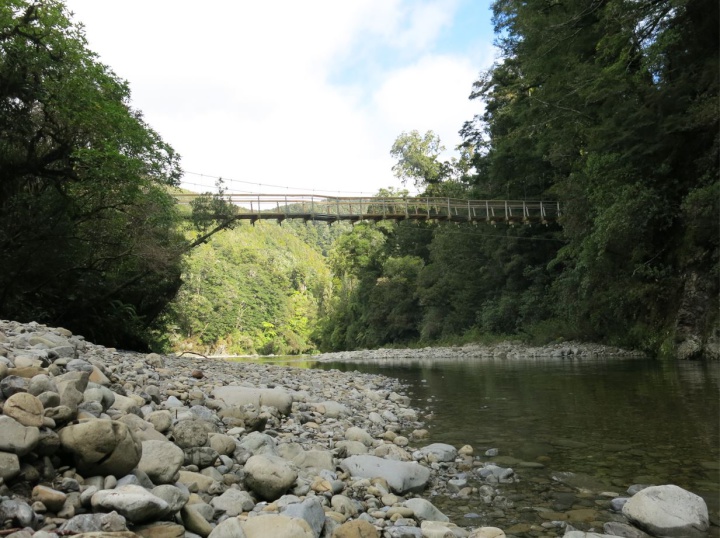Accessible Suspension Bridge Swings Into Action At Kaitoke Regional Park
The highly anticipated suspension bridge at Kaitoke Regional Park is now open, meaning more visitors can connect with nature at one of our region’s most beloved parks.

“Having the new bridge means I, like many others with access needs, can finally visit the rain forest on the other side of the Hutt River, something that hasn’t been possible until now,” says Genevieve McLachlan, who helped Greater Wellington ensure the bridge’s design was up to accessibility standards.

Genevieve McLachlan crosses the new Kaitoke swing bridge for the first time
Genevieve is a contractor for Be. Lab, an organisation which aims to make New Zealand the most accessible nation in the world. To do this, they work with organisations and citizens to enable greater accessibility for all, while redefining the way accessibility is thought about and discussed.
The new bridge makes it easier for the one in four New Zealanders with access needs or disabilities to experience the magnificent natural setting at Kaitoke. The bridge connects a stunning walk that goes through rainforest containing centuries-old rata, rimu, beech and the Hutt River gorge.
“It’s a fantastic outcome for our whole community,” says Greater Wellington Councillor and Upper Hutt local Ros Connelley, “People were a bit gutted when the bridge closed for construction earlier this year because it cut off access to a really well loved track. But everyone was a good sport about it, they understood the old bridge just wasn’t fit for purpose – it wasn’t wide enough to accommodate wheelchairs, prams, or the popularity of the track.”
On busy days, people would have to queue up to cross the bridge.
“The fact the view from the bridge makes for an ideal selfie location didn’t help with getting people across efficiently! Now, people will be able to cross in both directions at one time,” says Cr Connelley.
Genevieve reckons that the bridge is one of the first of its kind in New Zealand.
“When I did the initial research for the design plan review, I couldn’t find any similar bridges in New Zealand,” she says.
Built by Abseil Access, the bridge is a triumph of both engineering and the human spirit. Its unique location required the three-person team to camp overnight in the park for 45 days while construction was completed. When torrential rains fell in June, the team not only worked through the rain, they camped out in it.
The work involved a 15-foot crane truck, a chopper, and four days spent in the river as the team dismantled the old bridge piece by piece.
Once the bridge was officially opened, Genevieve was invited by Greater Wellington to be one of the first people to cross it. She describes it as an amazing experience – if a bit scary.
“Initially I wouldn’t look around but with encouragement, I quickly gained more confidence and looked at the amazing view. I just wanted to stay there. Being able to get into the rain forest on the other side was also amazing. I had no idea of its rich history. I’m looking forward to spending more time there in summer.
“I’d encourage anyone with access needs, whether you’re a parent with a pram, or use mobility equipment, to explore this amazing park and cross the bridge to the rain forest on the other side,” adds Genevieve.


 Gordon Campbell: On Marketing The Military Threat Posed By China
Gordon Campbell: On Marketing The Military Threat Posed By China Community Housing Aotearoa: Ngā Wharerau o Aotearoa Says New Partnership Model Helping Ensure Right To A Decent Home Is Realised
Community Housing Aotearoa: Ngā Wharerau o Aotearoa Says New Partnership Model Helping Ensure Right To A Decent Home Is Realised Greenpeace Aotearoa: Babies At Risk Due To Nitrate-Contaminated Drinking Water In Ashburton District
Greenpeace Aotearoa: Babies At Risk Due To Nitrate-Contaminated Drinking Water In Ashburton District Driving Change Network: Response To Government’s Proposed Driver Licensing Changes
Driving Change Network: Response To Government’s Proposed Driver Licensing Changes The New Zealand Remembrance Army: Victoria Cross And Hardham Cup Come Together For First Time In Over 100-years
The New Zealand Remembrance Army: Victoria Cross And Hardham Cup Come Together For First Time In Over 100-years RNZ Online: How The World Reacted To The Demise Of The Treaty Principles Bill
RNZ Online: How The World Reacted To The Demise Of The Treaty Principles Bill Te Matapihi: Response To Govt’s New Strategic Housing Partnerships: Progress, But Equity Gaps Remain
Te Matapihi: Response To Govt’s New Strategic Housing Partnerships: Progress, But Equity Gaps Remain


